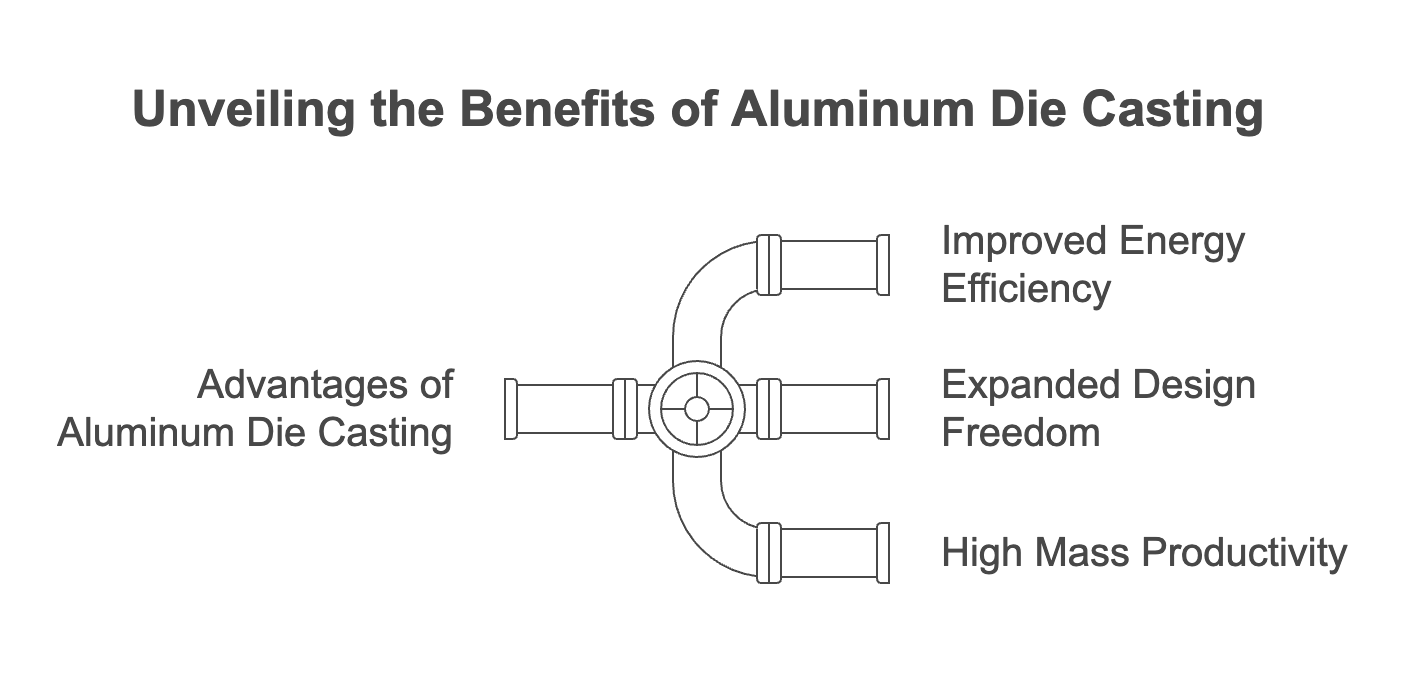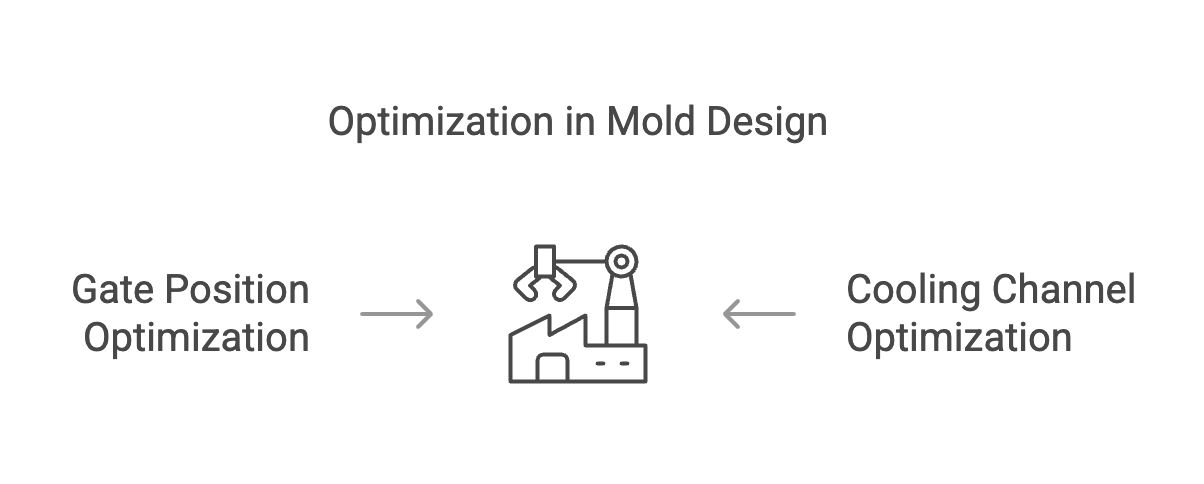◆Table of contents
ToggleIntroduction
Aluminum die casting is widely used in various industries, including automobiles and electronic equipment, as a manufacturing technology with excellent lightweight properties, durability, and the ability to realize complex shapes. Especially in the industrial machinery field, it is highly evaluated for its ability to improve energy efficiency by reducing the weight of parts and to increase the degree of freedom in design by realizing complex shapes. Furthermore, it is excellent in mass productivity and greatly contributes to the reduction of manufacturing costs.
In this article, we will explain in detail the technical approaches to achieving cost reduction and performance improvement through specific examples of aluminum die casting for industrial machinery. In particular, we will touch on cost competitiveness utilizing production in Vietnam and high-quality product provision through Japanese-style quality control.
Basic Properties of Aluminum Die Casting and Its Superiority in Industrial Machinery
Definition of Aluminum Die Casting and Overview of Manufacturing Process
Aluminum die casting is a manufacturing technology that fills molten aluminum alloy into a mold at high speed and forms it under high pressure. This process not only allows complex shapes to be reproduced with high precision, but also enables mass production in a short time. Aluminum alloys are lightweight yet strong, and also have excellent heat resistance and corrosion resistance, so they are widely used in various fields including industrial machinery.
Advantages of Adoption in the Industrial Machinery Field
Improved Energy Efficiency Through Weight Reduction
By manufacturing industrial machinery parts with aluminum die casting, the weight can be significantly reduced. For example, by reducing the weight of automated equipment frames and machine tool housings, the overall energy efficiency of the machine is improved, leading to a reduction in operating costs. Weight reduction plays an important role especially in fields requiring operating speed and operability, such as mobile construction machinery and robot arms.
Expansion of Design Freedom by Realizing Complex Shapes
Aluminum die casting can form complex shapes that are difficult to achieve with conventional cutting in a single process. This greatly increases the degree of freedom in design and makes it possible to enhance the functionality and performance of parts. For example, it can meet various needs such as housings with built-in cooling channels and brackets that are thin and lightweight yet maintain high rigidity.
High Mass Productivity and Cost Efficiency
Aluminum die casting is excellent in mass productivity because it can produce a large number of parts in a short time once the mold is completed. In addition, compared to cutting, there is less waste of material and the processing steps are simplified, which can significantly reduce manufacturing costs. Especially in the industrial machinery field, mass productivity of aluminum die casting is a great advantage because there are many cases where the same parts are used in large quantities.
Competitiveness of Production in Vietnam
Aluminum die casting production in Vietnam is said to be able to reduce manufacturing costs by 20-30% because labor costs are lower than in Japan and the local procurement rate is high. Furthermore, Japanese companies such as Daiwa Keikinzoku provide high-quality products by introducing Japanese-style quality control. The local procurement rate in Vietnam has reached 70-80%, and by procuring materials such as ADC12 alloy locally, transportation costs and lead times are also reduced.
Taking advantage of these properties, aluminum die casting plays an important role as a manufacturing technology that achieves both cost competitiveness and high performance in the industrial machinery field. In the next section, we will look at the effects in more detail through specific application examples.
Specific Examples of Aluminum Die Casting for Industrial Machinery
Automation Equipment
Application to Robot Arm and Frame Parts
In automation equipment, robot arms and frame parts are important components that require high-speed operation and high precision. By adopting aluminum die casting, it is possible to reduce the weight of these parts while achieving high rigidity and load resistance. For example, by manufacturing the frame of a robot arm with aluminum die casting, it is possible to reduce the weight by 20-30% and improve the operating speed and energy efficiency. Furthermore, since complex shapes can be formed in a single process, the processing steps can be shortened compared to cutting, and manufacturing costs can be reduced.
Required Characteristics
- Load Resistance: Strength to withstand loads during high-speed operation is required.
- Dimensional Accuracy: High dimensional accuracy is required to achieve precise operation.
Cost Reduction Effect
- Weight Reduction Rate: 20-30%
- Improved productivity by shortening the processing steps.
Machine Tools
Application to Spindle Housing and Base Frame
Spindle housings and base frames of machine tools are parts that require high heat resistance and vibration absorption. By adopting aluminum die casting, it is possible to meet these requirements while achieving weight reduction and cost reduction. For example, by manufacturing the spindle housing with aluminum die casting, the thermal conductivity is improved, and the accuracy and durability of the machine are improved. Furthermore, since complex internal structures can be formed in a single process, manufacturing costs can be reduced by 10-15%.
Required Characteristics
- Heat Resistance: Heat resistance to withstand heat generation during high-speed cutting is required.
- Vibration Absorption: Vibration absorption to achieve precision machining is required.
Cost Reduction Effect
- Manufacturing Cost Reduction: 10-15%
- Improved productivity by simplifying the processing steps.
Construction Machinery
Application to Engine Parts and Hydraulic Cylinder Parts
Engine parts and hydraulic cylinder parts of construction machinery require high load resistance and corrosion resistance to withstand use in harsh environments. By adopting aluminum die casting, it is possible to meet these requirements while achieving weight reduction and improved fuel efficiency. For example, by manufacturing hydraulic cylinder parts with aluminum die casting, it is possible to reduce the weight by 15-25% and improve fuel efficiency. Furthermore, by using ADC12 alloy with excellent corrosion resistance, it is possible to ensure durability that can withstand long-term use.
Required Characteristics
- Load Resistance: Strength to withstand use in harsh working environments is required.
- Corrosion Resistance: Corrosion resistance to withstand environmental factors such as rain and dust is required.
Cost Reduction Effect
- Weight Reduction Rate: 15-25%
- Reduced operating costs by improving fuel efficiency.
As can be seen from these specific examples, aluminum die casting is a powerful manufacturing technology to achieve weight reduction, cost reduction, and performance improvement at the same time in various parts of industrial machinery. In the next section, we will explain in detail the technical approaches to further enhance these effects.
Technical Elements to Achieve Cost Reduction
Optimization of Mold Design
Shortening Solidification Time by Optimizing Cooling Channels
By optimizing the cooling channels in the mold, the solidification time during the casting process can be shortened and the production cycle can be improved. If the design of the cooling channels is insufficient, some parts of the product will solidify early and other parts will solidify late, which will cause internal stress and cause distortion and cracking. By adopting optimized cooling channels, uniform cooling is achieved, product quality is improved, and production efficiency is increased. This can reduce manufacturing costs.
Reducing Casting Defects by Optimizing Gate Position
By optimizing the position of the gate (the part where molten metal flows into the mold), the flow of metal can be uniformed and the occurrence of casting defects (entrapment cavities and air bubbles) can be suppressed. If the gate position is inappropriate, the metal will cause turbulence in the mold and defects will easily occur. By designing the optimal gate position, the yield is improved and the occurrence of defective products can be suppressed. This reduces material waste and leads to cost reduction.
Casting Defect Reduction Technology
Use of Vacuum Casting Technology
Vacuum casting technology is a technology that reduces casting defects such as entrapment cavities and air bubbles by removing air from the mold. Especially in industrial machinery parts that require high precision, adopting vacuum casting can significantly reduce internal defects and improve the mechanical strength of the product. This increases durability and extends product life, enabling long-term cost reduction.
Improving Surface Quality by Selecting Release Agent
By optimizing the type and application method of the release agent, the surface quality of the casting can be improved. By using an appropriate release agent, release from the mold becomes smooth and surface scratches and scratches can be prevented. This eliminates the need for polishing and surface treatment in the post-process, reducing processing costs. Also, optimization of the release agent contributes to extending the life of the mold, which leads to long-term cost reduction.
Benefits of Local Procurement in Vietnam
Adoption of ADC12 Alloy and Local Procurement Rate (70-80%)
In Vietnam, ADC12 alloy (Al-Si-Cu alloy) is widely used and has excellent heat resistance, corrosion resistance, and castability. ADC12 alloy can be procured locally and can reduce transportation costs, which greatly contributes to the reduction of manufacturing costs. Daiwa Keikinzoku has increased the local procurement rate in Vietnam to 70-80%, realizing the efficiency of material procurement.
Reduction of Transportation Costs and Shortening of Lead Time
Local production in Vietnam can significantly reduce transportation costs. Also, because the local procurement rate is high, the material procurement lead time is shortened and the flexibility of the production schedule is improved. This not only allows us to respond quickly to customer needs, but also reduces inventory costs.
By combining these technical elements, it is possible to achieve both cost reduction and quality improvement in the aluminum die casting manufacturing process. In the next section, we will explain in detail the latest technology trends to achieve performance improvement.
Technical Trends for Performance Improvement
Evolution of Vacuum Casting Technology
Improved Mechanical Strength by Reducing Internal Defects
Vacuum casting technology is a technology that reduces internal defects such as entrapment cavities and air bubbles by removing air from the mold, and improves the mechanical strength of the product. Especially in industrial machinery parts that are subjected to high loads, adopting vacuum casting can significantly reduce internal defects and improve product durability. This extends the product life and also leads to a reduction in maintenance costs.
Application Examples for Automotive and Aircraft Parts
Vacuum casting technology is also widely used in the manufacture of automotive and aircraft parts. For example, in high-precision parts such as engine blocks and transmission housings, vacuum casting is used to reduce internal defects and achieve high reliability. These application examples greatly contribute to the technology transfer to industrial machinery parts.
Innovation of Heat Treatment Technology
Improved Durability by T6 Treatment
T6 treatment is a type of heat treatment performed on aluminum die-cast products, which improves the durability and mechanical properties of the product by combining quenching and tempering. By performing T6 treatment, the crystal structure of the aluminum alloy is optimized, and the tensile strength and fatigue resistance are significantly improved. This makes it possible to achieve high durability even in industrial machinery parts that are subjected to high loads.
Expansion of Application to High Load Applications
Due to the evolution of heat treatment technology, aluminum die-cast products can now be applied to higher load applications than before. For example, high durability can be ensured by performing heat treatment even in parts used in harsh environments such as hydraulic cylinder parts for construction machinery and spindle housings for machine tools. This improves product reliability and leads to improved customer satisfaction.
Use of Simulation Technology
Prediction of Metal Flow and Solidification Behavior
By using simulation technology, it is possible to predict metal flow and solidification behavior during the casting process in advance and suppress the occurrence of defects. For example, by simulating the metal flow in the mold, it is possible to design the optimal gate position and cooling channels and reduce casting defects. This reduces the number of prototypes and significantly reduces development costs.
Reduction of Development Costs by Reducing the Number of Prototypes
In the conventional prototyping process, it was necessary to find the optimal design by repeating prototyping many times. However, by using simulation technology, the number of prototypes can be significantly reduced, and development time and costs can be reduced. This shortens the time to market for new products and enhances competitiveness.
By using these technology trends, it is possible to achieve both performance improvement and cost reduction of aluminum die-cast products. In the next section, we will explain in detail the strengths of Daiwa Keikinzoku and the competitiveness of production in Vietnam.
Daiwa Keikinzoku’s Strengths and Competitiveness of Production in Vietnam
Cost Advantage of Production in Vietnam (20-30% Reduction Compared to Japan)
Daiwa Keikinzoku has achieved a 20-30% cost reduction compared to domestic production in Japan by utilizing production in Vietnam. This cost advantage is due to Vietnam’s low labor costs and high local procurement rate. In particular, by procuring major materials such as ADC12 alloy locally, transportation costs are reduced and the efficiency of the supply chain is improved. This makes it possible to provide customers with high-quality products at competitive prices.
Quality Assurance with JIS Standard Conformity Certification
Daiwa Keikinzoku provides aluminum die-cast products that conform to Japanese Industrial Standards (JIS), and has a well-established quality assurance system. By obtaining JIS standard conformity certification, product reliability and durability are guaranteed, which gains trust especially from Japanese companies. This quality assurance is an important factor for maintaining Japanese technical standards even in production in Vietnam.
High Local Procurement Rate and Supply Chain Efficiency
The local procurement rate in Vietnam has reached 70-80%, and by procuring major materials such as ADC12 alloy locally, transportation costs and lead times are significantly reduced. The high local procurement rate also contributes to the efficiency of the supply chain and increases the flexibility of the production schedule. This not only allows us to respond quickly to customer needs, but also reduces inventory costs.
Fusion of Japanese-Style Quality Control and Local Production in Vietnam
Daiwa Keikinzoku provides high-quality products by introducing Japanese-style quality control to local production in Vietnam. Japanese-style quality control is characterized by thorough process control and quality checks, and this method is also taught and instructed to local staff in Vietnam. This maintains Japanese technical standards even in production in Vietnam and strives to improve customer satisfaction.
Summary
Aluminum die casting supports the evolution of industrial machinery through weight reduction, improved design freedom, and cost reduction. Daiwa Keikinzoku’s strengths are cost competitiveness through production in Vietnam and high-quality product provision through Japanese-style quality control. We are also promoting technological innovations such as vacuum casting and providing optimal solutions to customers.


